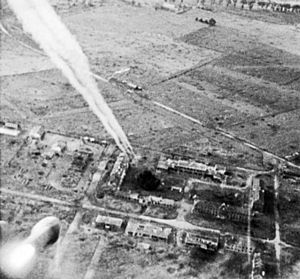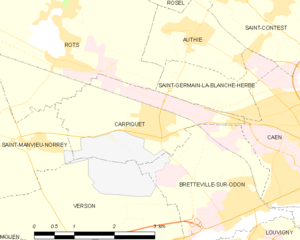Operation Windsor facts for kids
Quick facts for kids Operation Windsor |
|||||||||
|---|---|---|---|---|---|---|---|---|---|
| Part of Battle for Caen | |||||||||
 Rockets fired from a Hawker Typhoon of No 181 Squadron, RAF, at buildings on Carpiquet airfield. The 3rd Canadian Division took Carpiquet on 4 July. |
|||||||||
|
|||||||||
| Belligerents | |||||||||
| Commanders and leaders | |||||||||
| Strength | |||||||||
| 4 Infantry Battalions 1 Machine Gun Battalion 2 Armoured Regiments |
1 battalion each from SS Panzergrenadier Regiments 26 and 1 1 Flak Battery 15 tanks initially |
||||||||
| Casualties and losses | |||||||||
| 377 casualties 17 tanks |
c. 270 infantry, c. 20 tanks | ||||||||
Operation Windsor (July 4–5, 1944) was a Canadian attack during the Second World War. It was part of the larger Battle of Normandy. The main goal was for the 3rd Canadian Infantry Division to capture the village of Carpiquet and its nearby airfield. These areas were held by German soldiers from the 12th SS-Panzer Division Hitler Jugend.
The attack was first planned to happen during Operation Epsom. This was a week earlier. Its purpose was to protect the side of the main attack. But it was delayed. On July 4, the 8th Canadian Infantry Brigade and other Canadian units attacked Carpiquet. They had support from tanks and planes. The village was taken by the afternoon. However, German forces stopped two attacks on the airfield. The next day, Canadians fought off German counter-attacks. They held onto the village. Carpiquet then became a base for Operation Charnwood. This was another attack on Caen by the British Second Army. The airfield was finally captured by the Canadians on July 9.
Contents
Why Carpiquet Was Important
Caen was a major target for the Allies during Operation Overlord. British and Canadian forces landed on the beaches of Normandy on D-Day, June 6, 1944. Their plan was to capture Caen and the Carpiquet area quickly. But German resistance was strong. The city was not captured on D-Day. This was a surprise to the Allied commanders.
For the next three weeks, fighting continued around Caen. Both sides attacked and defended. They tried to gain small advantages. The Allies also wanted to keep German tanks busy near Caen. This would stop them from moving to fight the American army. The Americans were pushing south through the bocage (hedgerow country) towards St. Lô.
From June 26–30, the British Second Army launched Operation Epsom. This operation tried to go around Caen from the west. It aimed to capture high ground across the Orne River. The British advanced about 6 mi (9.7 km) through strong German defenses. But the Germans managed to stop them. The 3rd Canadian Infantry Division was supposed to capture Carpiquet in an operation called "Operation Ottawa." This was postponed.
After the Allied advance west of Caen, German forces held positions north and west of the city. Strong defenses were built near the River Orne and Carpiquet. Carpiquet was about 3.5 mi (5.6 km) north-west of Caen. It blocked any Allied advance towards Caen from the north. Capturing Carpiquet was a high priority for the Allies. They needed more airfields in Normandy. It was also a very important defensive spot for the Germans.
Getting Ready for Battle
German Defenses at Carpiquet
The Carpiquet airfield was on a flat area. This open ground was dangerous for attackers. The Germans had heavily fortified it. They placed minefields and many field gun and machine gun positions. These were manned by German soldiers and anti-aircraft guns. They also had about 15 tanks.
Allied Forces Prepare
Major-General Rod Keller led the 3rd Canadian Infantry Division. He chose the 8th Canadian Infantry Brigade to lead the attack. This brigade included The Queen's Own Rifles of Canada (QOR), Le Régiment de la Chaudière, and The North Shore (New Brunswick) Regiment. The Royal Winnipeg Rifles (RWR) also joined them.
Tanks and machine guns would support the attack. These came from the 10th Armoured Regiment, The Sherbrooke Fusiliers, and the Cameron Highlanders Support Battalion. Two squadrons of Hawker Typhoon fighter-bombers were added later. Also, three squadrons of specialized tanks from the 79th Armoured Division joined. On the evening of July 3, the battleship HMS Rodney fired shells at Carpiquet. It fired 15 large shells from 26,200 yd (24,000 m) away.
Operation Windsor was set to begin at 5:00 AM on July 4. First, 21 artillery regiments would bombard German positions. Then, Le Régiment de la Chaudière and The North Shore Regiment would attack Carpiquet. A squadron of the Sherbrooke Fusiliers would make a fake attack to the north. To the south, the RWR would advance and capture the airfield hangars. After the regiments took Carpiquet, the QOR would push through. They would take control of the airfield's control buildings. Capturing the airfield was key for future Allied attacks on Caen.
The Battle for Carpiquet
Fighting on July 4
As dawn broke on July 4, artillery units began firing. They created a moving wall of explosions. At 5:00 AM, two Canadian infantry battalions advanced on Carpiquet. The Sherbrooke Fusiliers made their fake attack to the north. They broke through German minefields. They attacked Chateau-St-Louet and Gruchy. But German defenses remained strong. They kept firing at the North Shores.
In the center, the Chaudières advanced on Carpiquet. They avoided much of the heavy fire. By 6:32 AM, both battalions reached the edge of the village. They met German tanks. A fierce house-to-house fight began in the village. Tanks from the 10th Canadian Armoured Regiment helped the infantry. They helped them overcome German positions.
To the south, the RWR moved slowly towards the airfield. German mortar fire caused many casualties. It took the RWR ninety minutes to advance 1.5 mi (2.4 km) to the airfield hangars. They were under fire from the south. Several Canadian Sherman tanks were destroyed. By midday, the RWR had to pull back. They went halfway to their starting positions.
Major-General Keller did not know the RWR had failed to take the airfield. He sent the QOR to start the second part of the attack. The QOR moved into Carpiquet village. The Chaudières and The North Shore were already there. They attacked German strong points that had been missed. Flame-throwers and special tanks helped. One strong point was burned, forcing 12 defenders to surrender. The rest of the German soldiers surrendered after a tough fight. The QOR reached the edge of Carpiquet. The RWR was pulling back. The QOR was told to hold their positions. They waited for the RWR to get ready for a second attack.
For the second attack on the airfield, Keller got support from two squadrons of Typhoon fighter-bombers. The RWR survivors were ordered to attack the airfield again. They had tank and artillery support. In the late afternoon, the RWR resumed their attack. They reached the hangars. But they could not remove the German defenders. The Canadian tanks met German Panther tanks. They were overwhelmed. The RWR was ordered to pull back under the cover of darkness. In Carpiquet, the 8th Canadian Infantry Brigade quickly strengthened its positions. These were the closest Allied units to Caen. The Canadians controlled Carpiquet and the northern hangars. But the southern hangars and control buildings remained in German hands.
German Counter-attacks on July 5
The 8th Canadian Infantry Brigade was less than 1 mi (1.6 km) from Caen. This was a big threat to German positions in the town. Most German defenses were north of Caen. They were also by the River Odon. The Germans feared the Allies could attack from Carpiquet. This would bypass most of their defenses.
Despite doubts about immediate counter-attacks, Kurt Meyer ordered his SS troops to retake Carpiquet. Units from the 1st SS-Panzer Division prepared to attack Carpiquet. They had tanks, artillery, mortars, and infantry.
Shortly after midnight, the first SS counter-attacks began. The 10th Canadian Armoured Regiment and Canadian mortars fought them off. Even though 13 tanks were lost the day before, the Canadians won. They caused many German casualties. By dawn, the Germans had gained almost no ground. By noon, the 8th Canadian Infantry Brigade and 10th Canadian Armoured Regiment had defeated three counter-attacks. Artillery and Typhoon fighter-bombers helped. The village remained firmly under Canadian control. However, it was often shelled by German Nebelwerfer rockets and mortars.
Results of the Battle
Casualties
Canadian losses for Operation Windsor totaled 377 soldiers. Of these, 127 men were killed. Most of these deaths happened on July 4. The RWR and The North Shores each lost 132 soldiers. The 10th Canadian Armoured Regiment lost 17 tanks. The Sherbrooke Fusiliers also lost an unknown number of tanks.
The German I Battalion, Panzer-grenadier Regiment 26 had 155 infantry casualties. The 1st SS-Panzer Division, which counter-attacked on July 5, lost c. 20 tanks. The II Battalion, Panzer-grenadier Regiment 1 had 115 casualties.



